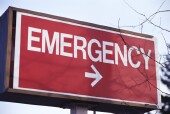
TUESDAY, Nov. 25, 2014 (HealthDay News) — The number of emergency department visits in the United States rose from about 130 million in 2010 to a record 136 million in 2011, according to the U.S. Centers for Disease Control and Prevention.
The findings also showed that fewer people were going to ERs with non-urgent medical needs: 96 percent of patients were identified as needing medical care within two hours of arriving at the ER. In 2010, that number was 92 percent, according to the research.
Sixty percent of patients arrived at the ER after normal business hours (after 5 p.m. on weekdays). One-third of visits were for patients on either end of the age spectrum — younger than 15 or older than 65, the researchers found.
Almost 30 percent of visits were for injuries. The highest injury rates were among patients 75 and older, the study noted.
“The report also finds that there are large numbers of admitted patients who wait long times for inpatient beds,” Dr. Michael Gerardi, president of the American College of Emergency Physicians (ACEP), said in an ACEP news release.
“Nearly two-thirds of patients waited two or more hours for beds in 2011, and nearly three-quarters of hospitals continued to board patients, even when the emergency department was critically overloaded. Hospitals must move admitted patients out of the emergency department faster to make room for the increasing number of people coming,” he said.
It’s believed that there will be about 140 million ER visits in 2014, according to the ACEP.
“The growth in patient demand aligns with what emergency physicians have been seeing and predicting: demand is going to increase,” Gerardi said.
“Given that our nation’s population is aging, and emergency departments have a critical role as the front line of responding to disasters and infectious disease outbreaks in America, such as what we saw with Ebola, we need to prepare for increased numbers of patients,” he added.
Despite increasing use of ERs, most hospitals had not expanded their ERs as of 2011 and had no plans to expand them in the following two years, according to Gerardi.
“Emergency departments are essential to every community and must have adequate resources,” he said. “They continue to be under severe stress and face soaring demands, despite the efficiency of caring for more than 136 million of the sickest patients each year using only 4 percent of the nation’s health care dollar. This report is more evidence that we are going to need more resources, not less, in the future.”
More information
The U.S. National Library of Medicine has more about emergency medical services.
Copyright © 2025 HealthDay. All rights reserved.

